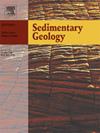Sedimentology of a drowned carbonate platform from the Sciacca area (southwestern Sicily): Insights into the Jurassic palaeogeography of Western Tethys
IF 2.9
2区 地球科学
Q1 GEOLOGY
引用次数: 0
Abstract
A sedimentological-stratigraphic study of the Mesozoic carbonates exposed in two inactive quarries in southwestern Sicily has provided new insights into the palaeogeographic evolution of the southern sector of the Western Tethys margin during the Jurassic.
The Lower–Upper Jurassic succession consists of shallow-water peritidal carbonates, intersected by neptunian dykes and sills, which transition upwards into condensed pelagic limestone. Microfacies analysis of the shallow-water peritidal carbonates has led to their reassignment to the Hettangian–Pliensbachian (p.p.), previously attributed to the Late Triassic. Furthermore, variations in biodiversity within these stratigraphic horizons reflect the survival and recovery interval following the end-Triassic mass extinction event.
The abrupt transition to condensed pelagic limestone indicates the drowning of the carbonate platform. Lateral facies variations observed within the condensed pelagic limestone suggest different sedimentological processes, influenced by a complex system of structural highs and basins related to the Pangea continental rift. The presence of distinctive micro- and macrofacies, such as micritic oolites and Fe![]() Mn hardgrounds, indicates a varied palaeotopographic setting for each section, where sedimentation is further controlled by bottom-current activity and low sedimentation rates.
Mn hardgrounds, indicates a varied palaeotopographic setting for each section, where sedimentation is further controlled by bottom-current activity and low sedimentation rates.
西西里岛西南部Sciacca地区溺沉式碳酸盐岩台地沉积学:西特提斯地区侏罗纪古地理研究
对西西里岛西南部两个不活跃采石场中暴露的中生代碳酸盐岩进行沉积地层学研究,为西特提斯边缘南段侏罗纪时期的古地理演化提供了新的认识。下侏罗统-上侏罗统由浅水潮外碳酸盐岩组成,由海王星岩脉和岩台相交,向上过渡为凝聚的远洋灰岩。通过对浅水潮旁碳酸盐岩的微相分析,将其重新定位为hettangan - pliensbachian (p.p.),以前被认为是晚三叠世。此外,这些地层层位内生物多样性的变化反映了三叠纪末大灭绝事件后的生存和恢复间隔。向凝结的远洋灰岩的突然转变表明碳酸盐台地被淹没。在凝结的远洋灰岩中观察到的侧向相变化表明,受与盘古大陆裂谷有关的复杂构造高地和盆地系统的影响,沉积过程不同。不同微相和大相的存在,如泥晶鲕粒和FeMn硬岩,表明每个剖面具有不同的古地形背景,其中沉积进一步受到底流活动和低沉积速率的控制。
本文章由计算机程序翻译,如有差异,请以英文原文为准。
求助全文
约1分钟内获得全文
求助全文
来源期刊

Sedimentary Geology
地学-地质学
CiteScore
5.10
自引率
7.10%
发文量
133
审稿时长
32 days
期刊介绍:
Sedimentary Geology is a journal that rapidly publishes high quality, original research and review papers that cover all aspects of sediments and sedimentary rocks at all spatial and temporal scales. Submitted papers must make a significant contribution to the field of study and must place the research in a broad context, so that it is of interest to the diverse, international readership of the journal. Papers that are largely descriptive in nature, of limited scope or local geographical significance, or based on limited data will not be considered for publication.
 求助内容:
求助内容: 应助结果提醒方式:
应助结果提醒方式:


